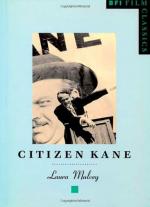|
This section contains 713 words (approx. 3 pages at 300 words per page) |

|
Welles did not invent any new cinematic processes: he fused the experience of three decades into one gigantic work that proclaimed with tremendous power just how effective a medium the cinema could be. He assimilated the styles and subtleties the cinema had evolved, often unwittingly, since Griffith. For practically every technical device in Citizen Kane there is a precedent; but there is no precedent for Citizen Kane, the film. (pp. 18-19)
Welles's vision is expressed not so much in Fordian terms as in the style of the German directors of the Twenties. The relaxed bonhomie of Ford's world eludes him, except in parts of The Stranger and Chimes at Midnight. But Welles uses architecture with much [strength]…. The castle wreathed with clouds at the start of Citizen Kane and Macbeth is remote, haunting, and Wagnerian in its suggestion of power. Arkadin's turreted headquarters in Spain, the clock tower...
|
This section contains 713 words (approx. 3 pages at 300 words per page) |

|


